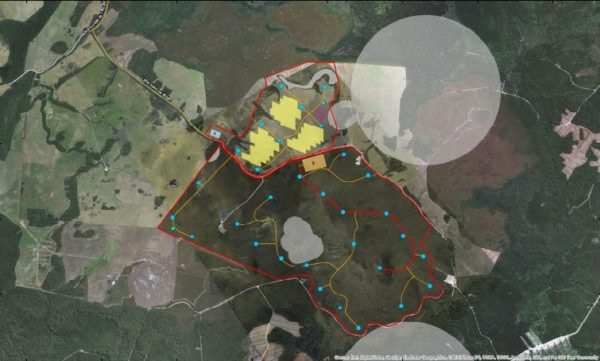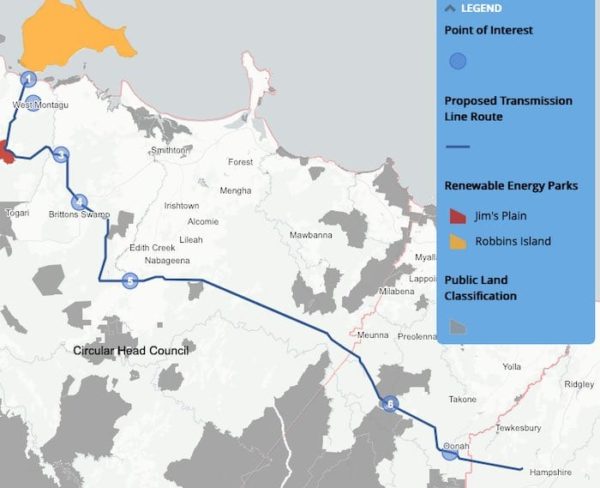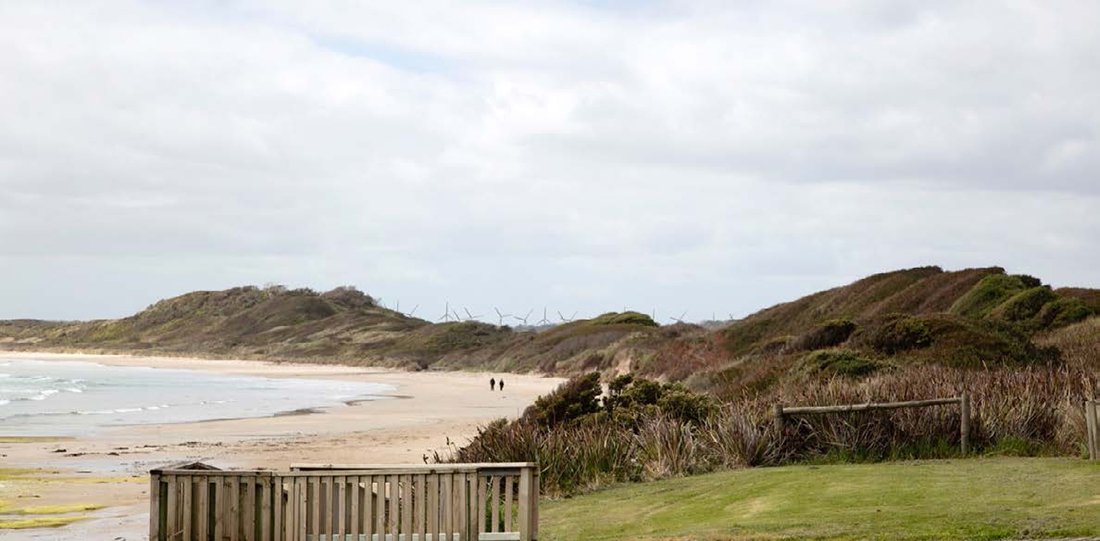Jim’s Plain Renewable Energy Park may sound like an off-the-shelf home-brand renewables project, but as part of a multifaceted development in the scenic northwest of Tasmania, it has been contentious. Last week, the Commonwealth Government signed off on development approval for the park, which will allow the UPC\AC Renewables Australia joint-venture to proceed with this first phase of a proposal that could ultimately add more than 1000 MW of renewable capacity to the NEM.
Approved by the Tasmanian Environmental Protection Authority and the Circular Head Council (the local Tasmanian government body covering the far north west of the state), Jim’s Plain Renewable Energy Park will consist of up to 31 wind turbines and solar PV, with a combined capacity of 240 MW.

Image: UPC\AC Renewables Australia
“It has taken a lot of hard work supported by detailed investigations, to reach this important milestone,” said David Pollington, Director and Chief Operating Officer of UPC Renewables in Australia, in a statement.
UPC Renewables is a Hong Kong-based global renewables developer which claims a 5 GW pipeline of projects worldwide. AC Energy, its 50:50 partner in the Australian-domiciled company UPC\AC Renewables Australia, is the energy arm of one of the largest business groups in the Philippines, known as Ayala.
Under the name of UAC, the JV also last month announced a takeover bid for Infigen Energy, Australia’s largest ASX-listed renewable energy generator. The outcome of a bidding war for Infigen between Spanish Bilbao-based utility Iberdrola and UAC has not yet been decided.
Three-pronged 600-1000 MW package of developments
Approval by the Commonwealth Government of the Jim’s Plain project, near the town of Smithton on Tasmania’s north coast will enable UPC\AC Renewables to focus on finalising development of its Robbins Island Renewable Energy Park, on the island of the same name slightly further to the north west.
The 9,900-hectare island is privately owned by the Hammond family, and consists of coastal heath and pasture, where Wagyu beef cattle put on fat to insulate them from the brunt of the Roaring Forties — a ripping wind resource.
The first phase of the UPC/AC Robbins Island project is for a 340 MW wind farm; a second phase of development, which could increase that by more than 400 MW is dependent the developer says on the Marinus Link interconnector between Tasmania and mainland Australia being given the green light.
Last month the Federal Government pledged to fast-track approvals of the 1,500 MW-capacity Marinus Link under its JobMaker program.
UPC/AC plans to “export” its Robbins Island resource with a new 220 kV, 115-kilometre transmission line which it will run via cables embedded in a bridge it proposes building from Robbins Island to mainland Tasmania; and then via transmission towers, picking up Jim’s Plain resources on the way, to Hampshire where it will connect to TasNetworks’ line to Staverton.

Image: UPC\AC Renewables Australia
The Hampshire-to-Staverton line is being developed by TasNetworks as part of its North West Transmission Development which is intended to optimise renewable energy delivery to the NEM via Marinus Link, and utilising proposed Battery of the Nation pumped-hydro storage capabilities.
“The Jim’s Plain development, along with the Robbins Island development, will deliver low-cost energy and, coupled with hydro, provides dispatchable, affordable, reliable clean energy for Tasmania and interstate,” said Pollington.
Wind resources complimentary, but visually … not so much
UPC/AC Renewables says on its website that the nature of the wind resource of northwestern Tasmania “will allow the wind turbine generators to operate at over 90% capacity with a little or no correlation to Victorian and South Australian wind farms. The lack of correlation means that the projects are highly complementary to the existing and planned generation in the National Electricity Market.”
Nature conservation, and the preservation of pristine Tasmanian landscape outlooks have formed the basis of the strongest opposition to the UPC/AC developments.
Dr Bob Brown, former Australian senator and parliamentary leader of The Greens party, was accused of hypocrisy by Tasmania’s energy minister Guy Barnett, when he objected to the Robbins Island wind farm on the basis that it was incompatible with endangered bird species on the island, including the Tasmanian wedge-tail eagle and the white-breasted sea eagle.
“We have alternatives for renewable energy. We don’t have alternatives for extinct species of birds,” Brown told the ABC’s 7.30 program mid last year.
“There is a lot of untapped renewable energy, solar, wind and other resources potential in Australia,” he added. “We should be looking at the whole suite of those and determining as a community which to develop, not leaving it to developers who have profits in mind.”
The 270-metre-tall wind turbines on Robbins Island will likely be visible from the mainland on some days, and the transmission towers, at 45 to 55 metres high will march across the region’s spectacular scenery at 400 metre intervals.
But the sense of loss of natural assets, and the desire to create jobs in the region were also shown to be incompatible — 150 people are expected to be employed during the two-year construction period of the Jim’s Plain project, which should also generate up to 15 ongoing jobs — and when the Tasmanian EPA was satisfied that the Jim’s Plain project could be managed in an environmentally sustainable manner, the domino of approvals continued.
Concessions to heritage and nature concerns
On Jim’s Plain, UPC/AC Renewables has excluded the old-hollow-tree habitats of Tasmanian masked owls from its development zone. On Robbins Island it will exclude areas where Indigenous artefacts have been found; it has committed to ensuring one-kilometre exclusion zones around eagle nests, and will maintain a coastal buffer to protect the nesting areas of shorebirds, among other measures.
The projects have since been referenced in the Draft Tasmanian Renewable Energy Action Plan (TREAP), which outlines the state government’s pathway and intentions to achieving a 200% renewable energy target by 2040, and to become an exporter of renewable hydrogen by 2030.
It says 10 renewable projects throughout the state “have the potential to provide billions of dollars of regional investment and significant construction and ongoing employment”.
The $1.5 billion UPC/AC triple hit of renewable parks and transmission is expected to create a total of 400 jobs during construction and 65 ongoing roles.
Trade mission: become sustainable in Tassie
The TREAP refers also to the state government’s intention to market Tasmania to overseas high-energy-using industries as a location that will satisfy their need to become more sustainable, its aim being to use its renewable resources to establish “jobs-rich, large-scale” enterprises in Tasmania.
It says: “Tasmania is well on target to achieve the government’s goal of becoming 100 per cent self-sufficient in renewable energy generation by 2022. This represents a significant competitive advantage for Tasmania in seeking to attract energy intensive industries for whom sustainability is a key requirement.”
Tasmania’s Department of State Growth welcomes submissions in response to the Draft TREAP; the deadline for submissions is 11 September, 2020.
This content is protected by copyright and may not be reused. If you want to cooperate with us and would like to reuse some of our content, please contact: editors@pv-magazine.com.









By submitting this form you agree to pv magazine using your data for the purposes of publishing your comment.
Your personal data will only be disclosed or otherwise transmitted to third parties for the purposes of spam filtering or if this is necessary for technical maintenance of the website. Any other transfer to third parties will not take place unless this is justified on the basis of applicable data protection regulations or if pv magazine is legally obliged to do so.
You may revoke this consent at any time with effect for the future, in which case your personal data will be deleted immediately. Otherwise, your data will be deleted if pv magazine has processed your request or the purpose of data storage is fulfilled.
Further information on data privacy can be found in our Data Protection Policy.